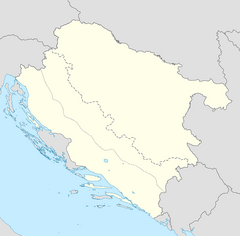
Summary
Garavice (Serbian Cyrillic: Гаравице) was an extermination location established by the Independent State of Croatia (NDH) during World War II in Yugoslavia near Bihać, in the Independent State of Croatia. Between 7,000 and 12,000 people, mostly Serbs and Jews were murdered at Garavice by the Ustasha in 1941.[1]
| Garavice | |
|---|---|
| Nazi extermination site | |
 The Garavice Memorial Park to the Victims of Fascist Terror by Bogdan Bogdanović commemorates the Serbs, Jews and Roma massacred at Garavice | |
 Location of Garavice in the Independent State of Croatia | |
| Coordinates | 44°49′27″N 15°50′27″E / 44.82417°N 15.84083°E |
| Location | near Bihać, Independent State of Croatia |
| Operated by | Independent State of Croatia and Ustashas |
| Operational | July 1941 – September 1941 |
| Inmates | primarily Serbs, Jews and Roma |
| Killed | 7,000-12,000 |
| Liberated by | Yugoslav Partisans |
The killings in Garavice were part of a widespread genocide of Serbs, that included expulsions, forced religious conversions, massacres or ethnic Serbs by the Ustasha regime in the Independent State of Croatia. These atrocities were carried out by Croat collaborators and Axis occupying forces during World War II.[2][3][4][5]
Background edit
The Independent State of Croatia (NDH) was founded on 10 April 1941 by the Axis powers (after the invasion of Yugoslavia), who installed the fascist Ustasha organization as the puppet government. The Independent State of Croatia consisted of most of modern-day Croatia and all of modern-day Bosnia and Herzegovina, together with some parts of modern-day Serbia and Slovenia.[6] NDH was the only nation beside Germany to operate extermination camps during World War II.[7][better source needed]
Some of the first decrees issued by the Poglavnik of the Independent State of Croatia, Ante Pavelić, reflected the NDH's adoption of the racist ideology of Nazi Germany towards Jews and Serbs.[8]
Mass murders edit
Arrests of Serb and Jewish civilians in and around Bihać were ordered by Ljubomir Kvaternik, a county prefect, in June 1941. Arrestees were transported and executed at Garavice, near Bihać. In July 1941, the Ustashas murdered between 7,000-12,000 Serbs, Jews, and Roma in Garavice.[9] The largest number of victims were Serbs. Corpses were thrown in mass graves at Garavice or tossed into the nearby Klokot and Una rivers.[10][11] A large amount of blood contaminated the local water supply.[12]
Memorial Park edit
In 1981, the Yugoslav government established a memorial park in Garavice, designed by renowned architect Bogdan Bogdanović and opened 39 years after the massacre. In 2011, the memorial park was declared a national monument of Bosnia and Herzegovina.[13] Since then, however, the park has reportedly been neglected by the Bosnian government, and is overgrown with weeds and bushes, and desecrated with Nazi and Ustasha graffiti.
See also edit
References edit
- ^ "Spomenik Database | Garavice Memorial at Bihać". spomenikdatabase. Retrieved 2023-08-06.
- ^ "Serbian Genocide". combatgenocide.org. Retrieved 5 September 2015.
- ^ MacDonald, David Bruce (2002). Balkan Holocausts?: Serbian and Croatian Victim Centered Propaganda and the War in Yugoslavia (1.udg. ed.). Manchester: Manchester University Press. p. 261. ISBN 978-0-7190-6467-8.
- ^ Mylonas, Christos (2003). Serbian Orthodox Fundamentals: The Quest for an Eternal Identity. Budapest: Central European University Press. p. 115. ISBN 978-963-9241-61-9.
- ^ Jonsson, David J. (2006). Islamic economics and the final jihad: the Muslim brotherhood to Leftist/Marxist - Islamist alliance. Xulon Press. p. 504. ISBN 978-1-59781-980-0.
- ^ "Garavice kod Bihaća: Pomen za 14.500 stradalih Srba, Jevreja i Roma". glassrpske.com. 6 August 2016. Retrieved 15 July 2017.
- ^ Pavlowitch, Stevan K. (2008). Hitler's New Disorder: The Second World War in Yugoslavia. New York: Columbia University Press. ISBN 1-85065-895-1.
- ^ Lemkin, Raphael (2008). Axis Rule in Occupied Europe. The Lawbook Exchange, Ltd. ISBN 9781584779018.
- ^ "Spomenik Database | Garavice Memorial at Bihać". spomenikdatabase. Retrieved 2023-08-06.
- ^ The Yugoslav Auschwitz and the Vatican, Vladimir Dedijer, Gottfried Niemietz, Harvey L. Kendall, 1992, Prometheus Books; ISBN 0-87975-752-3, page 34.
- ^ "ПРВИ ОКРУГЛИ СТО "ГАРАВИЦЕ 1941" | Јадовно 1941". jadovno.com. 15 December 2011. Retrieved 15 July 2017.
- ^ Bergholz, Max (2012). "None of us Dared Say Anything: Mass Killing in a Bosnian Community during World War Two and the Postwar Culture of Silence" (PDF). University of Toronto. p. 76.
- ^ "Commission to preserve national monuments". 2014-10-19. Archived from the original on 2014-10-19. Retrieved 2021-07-17.


